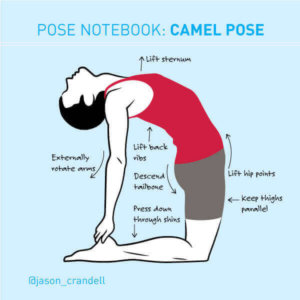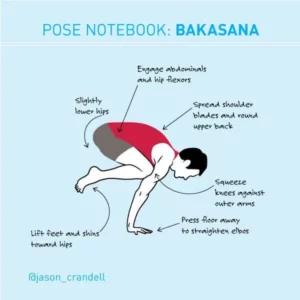Bakasana is iconic. For modern yoga practitioners, the pose not only represents strength, skill, and control, it symbolizes the entire concept of arm balancing. Practicing Bakasana pose builds self-confidence by reminding us that we’re stronger and more capable than we think.
Part of Bakasana’s charm is that it’s challenging but accessible to all levels. It doesn’t require ridiculously open hips like many of other arm balances. And even if you can’t yet do the pose, you feel like you’re on the cusp of floating into it for the first time—if only that last toe would finally lift off the ground.
A side note about the nomenclature of the pose before I go further: The technical transliteration of Bakasana is Crane Pose. But, for some reason, Crane just never stuck in American yoga vernacular. So, most of the time you’ll hear it referred to as Crow pose. I’ve heard people swear that the bent arm (beginner) version is Crow and when you work up to straight arms it’s called Crane. For the sake of ease, I’ll refer to it as Crow pose from here on out.
From a purely mechanical perspective, Bakasana is the foundation for a larger family of postures that include Parsva Bakasana (Side Crow) and two versions of Eka Pada Bakasana (One-Footed Crow). So, whether you apsire to practice these demanding relatives, or you just want to finally lift that last, stubborn toe off the ground in Bakasana, here’s how to hone your game.
WARM UP
Bakasana is a combination of Chaturanga and Plank in your upper body, and a deep squat in your lower body. Bakasana also requires substantial engagement of your inner legs and abdominals. This means that you should prepare for the pose by warming up these regions. A quick, simple way to do this is to practice a few Low Lunge Sun Salutations. A few quick core strengtheners would also be helpful. Here’s the perfect core mini-sequence. Lastly, check out this fully-illustrated 16-pose sequence for Bakasana.
HOW-TO
1. Come into a squat with the inner edges of your feet together and your knees separated wider than your shoulders.
2. Lean your upper body forward between your knees. Reach your arms forwand and place your finger tips on the floor in front of your shoulders. Check to make sure your arms are reaching between your knees, not on the outside of your knees.
3. Bend your elbows slightly and press the backs of your arms and your shins against each other.
4. Lift your hips slightly, lean forward, and place your hands on the floor slightly in front of your shoulders. Intensify the squeeze of your legs against your outer arms and engage your abdominals by drawing your navel towad your spine.
4. You’re set. You’re ready. You’re there. Now you just need to take off and here’s the most important tip of this column: Instead of trying to “lift” into Bakasana, lean your weight forward until your feet naturally rise up off the floor. It may seem counterintutive, but you’re not “lifting” into the pose—you’re leaning forward until the weight is on your hands instead of your feet.
5. Once you’ve leaned forward and found your balance point, hone your posture by executing the actions in the infographic.
6. After a few breaths—and, a few photographs for your next round of marketing collateral—slowly lower your feet to the floor. Or, if you prefer a more challenging exit, draw your chest forward and shoot your legs back into Chaturanga.
IF I CAN’T DO BAKASANA YET, WHAT SHOULD I DO INSTEAD?
Bakasana may be simple, but it’s a challenging pose. If you’re not able to do the pose there’s plenty of hope. If you suspect that your core and upper body are not aren’t strong enough, practice Boat Pose and Plank more frequently. You can also do Bakasana on your back to strengthen your core. It’s the perfect way to do the pose if it’s inaccessible on your hands! If you’re not flexible enough to fold into the squat, practice Happy Baby Pose like it’s going out of style.
PART II: ANATOMY AND SEQUENCING FOR BAKASANA
WHICH MUSCLES DOES BAKASANA POSE STRENGTHEN?
Your abdominals and pelvic floor
All of your abdominal and pelvic floor muscles are working to keep your pelvis lifted in Bakasana. Your transverse abdominis and rectus abdominis are working even more intensely than your obliques since the posture doesn’t include spinal rotation.
Your hip flexors
Your hip flexors, especially your psoas and iliacus, are working to flex your hip and help keep your knees elevated on your arms.
Your inner legs
All of your adductors are firing in Bakasana. Combined, they have two roles: to work with the psoas and iliacus to flex your hip, and to help hold your knees fixed against your outer upper arms.
Your hamstrings
Your hamstrings are working to lift your shins and feet away from the floor.
Your shoulders
Your shoulders play a huge role in Bakasana. Your rotator cuff group stabilizes the position of your upper arms in their sockets; your deltoids help support the weight of your body; your serratus anterior helps broaden your scapula, and your pecs work to support the weight of your body.
Your arms
Of all the muscles in your arms and hands, your triceps have the greatest duty in Bakasana. They are strongly contracted in order to resist the downward force of gravity. In order to straighten your arms in the pose, your triceps have to work strongly.
WHICH MUSCLES DOES BAKASANA STRETCH?
No pun intended, but it’s a bit of a stretch to say that you’re stretching much of anything when you practice Bakasana. The pose is heavily skewed to muscular contraction. That said, you may be getting a minor stretch in the following:
Your Rhomboids and Trapezius
Your rhomboids and the middle fibers of your trapezius get a mild stretch as you broaden your shoulder blades and flex your spine.
Your Spinal Muscles
Your paraspinal muscles receive a mild stretch when you round your back in Bakasana.
SEQUENCING FOR BAKASANA
You can find a fully-illustrated, 16-pose sequence for Bakasana here.
{illustration by MCKIBILLO}





